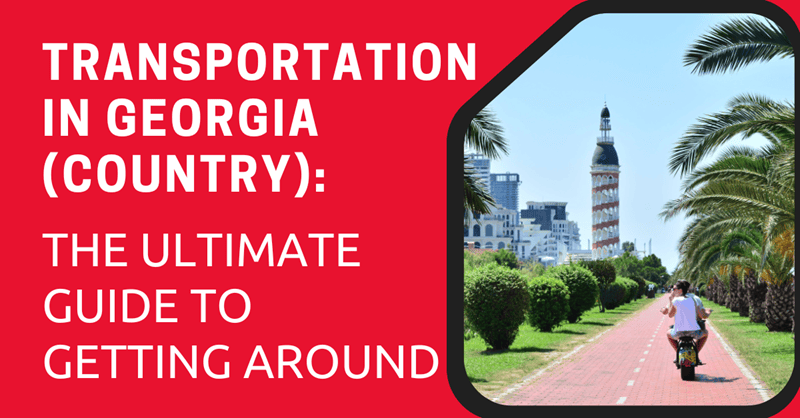
Your complete 2025 guide to navigating Georgia. Learn how to use the bus, train, marshrutka, Bolt, and rental cars. Includes insider tips on cost, safety, and booking for travelers and expats.
I never had any real interest in Georgia until I discovered its perks for digital nomads. That’s when I started digging deeper into the country, and one of the first things that caught my attention was the transportation system. Getting around here is quite unique, especially because of something called a marshrutka.
These are shared minibuses that serve as the backbone of public transport in many parts of the country. There are no official schedules, no apps to track them, and barely any English signage. You just show up at a place like Didube Bus Station in Tbilisi, wait around, and eventually a driver will shout something like “Kazbegi!” to signal their destination.
Georgia may be a small country, but transportation isn’t always straightforward. English isn’t widely spoken outside major cities, and options vary depending on where you’re going. But once you understand how the system works, when to use public transit, when to call a Bolt, and when it makes sense to rent a car, it all starts to feel more manageable.
Based on my research and what other travelers and expats have shared, I’ve put together this guide to help you figure out the best way to get around Georgia, whether you’re heading into the mountains, exploring wine country, or just getting across town in Tbilisi.
This guide is for:
- Budget travelers trying to avoid tourist traps and overpriced taxis
- Families and retirees looking for reliable, comfortable options between cities
- Digital nomads and long-term expats figuring out daily transport or planning weekend trips
Let’s get started.
This article will take approximately 31 minutes to read. Don't have the time right now? No worries. Email the ad-free version of the article to yourself and read it later!
Disclaimer: This article may include links to products or services offered by ExpatDen's partners, which give us commissions when you click on them. Although this may influence how they appear in the text, we only recommend solutions that we would use in your situation. Read more in our Advertising Disclosure.
Contents
- Good to Know About the Transportation System in Georgia
- An Overview of the the Transportation System in Georgia
- Is Uber available in Georgia?
- Is public transportation accessible for seniors or people with disabilities?
- Can I pay for buses in Tbilisi with my foreign credit card?
- Do I need an International Driving Permit (IDP) to rent a car in Georgia?
- What is the absolute cheapest way to travel across Georgia?
- How do I get from Tbilisi Airport to the city center?
- How much does a taxi from Tbilisi Airport to the city center cost?
- Is it safe to drive in Georgia?
Good to Know About the Transportation System in Georgia
Coming from Thailand, I’ve noticed so many similarities between the transportation systems here and in Georgia. Both countries rely heavily on informal setups like shared minibuses, and figuring things out often means asking locals or just going with the flow.
To help you quickly understand the transportation system in Georgia, there are some important points to note. Here’s what’s good to know about getting around here.
- Affordable and accessible: One of our writers who lived in Georgia told me that getting around was often just $1. I was honestly surprised, it’s even cheaper than getting around in Thailand. Metro rides in Tbilisi cost just a few cents, and long-distance marshrutkas rarely go over 25 GEL (around $9 USD).
- A mix of old and new vehicles: Don’t be surprised to see a modern, air-conditioned bus right behind a marshrutka that looks like it’s from the early ’90s.
- Loosely structured but reliable: While there are official timetables, not everything runs exactly on schedule. Marshrutkas, for example, often leave when full. Still, people generally get where they need to go without much trouble.
- Urban convenience, rural limitations: Big cities like Tbilisi, Batumi, and Kutaisi have solid infrastructure, including public buses, taxi apps, and good road networks. In rural areas like Tusheti or Svaneti, options are fewer. Expect fewer scheduled services, rough roads, and long waits between connections.
Tip: The key to getting around in Georgia is flexibility. If you expect Japanese-style precision, you’ll be frustrated. But if you’re open to a more laid-back system, Georgia’s transport network can take you just about anywhere, eventually.
An Overview of the the Transportation System in Georgia
Transportation in Georgia is surprisingly good, and very affordable. In cities like Tbilisi, you’ll find modern services like a clean, fast metro. But then, on your next trip, you might find yourself on a city bus that looks like it came straight out of the 90s. It’s a mix of the modern and the outdated.
While it’s not perfect, it works and covers most of the country. Here are the main options available:
- Metro (Tbilisi only): Two lines, fast and reliable. Great for daily commuting within the capital.
- City Buses: Operate in Tbilisi, Batumi, Kutaisi, and other cities. Inexpensive, modern, and use prepaid cards.
- Marshrutkas (Minibuses): The backbone of local and regional travel. They leave when full and cover almost every town and village.
- Taxis: Widely available but often without meters. Use apps like Bolt or Yandex Go to avoid haggling.
- Trains: Comfortable options between major cities, including the Tbilisi–Batumi express. Slower but scenic.
- Domestic Flights: Limited routes, mainly between Tbilisi and Mestia. Useful if you want to skip mountain roads.
- Car Rentals and Private Drivers: Best for exploring remote regions like Svaneti, Tusheti, or Kakheti wine country.
Urban vs. Rural Access
- Tbilisi, Batumi, Kutaisi: Well-connected with metro, buses, taxis, and ride-hailing apps. Easy for daily travel.
- Rural and Mountain Regions: Transport gets sparse. Marshrutkas might run once or twice a day. Roads can be rough, and some places are only accessible by 4WD.
Let’s take a closer look at each transportation option and see which one works best depending on where you are and where you’re headed.
Getting Around Cities
Georgia’s major cities are compact and well-connected, making it easy to get around without a car. Public transportation is both affordable and quite easy to navigate once you know how the system works.
Tbilisi Metro
Operating hours: daily from around 6:00 AM to midnight, with short wait times throughout the day.
Cost: 1GEL per ride
The metro is one of the fastest and most reliable ways to get around Tbilisi, especially during rush hour when traffic can be very heavy. It’s going to be a go-to transportation option for expats. It’s not like Tokyo or Singapore where the metro covers most parts of the city, but here, it’s still convenient for getting into the city center and switching between neighborhoods.
*It’s also worth noting that the metro system exists only in Tbilisi
Available Routes
Most expats I know use the metro as their main way of getting around the city. It gets you close enough to your destination, and then you just walk the last few blocks. In many cases, it’s quicker than sitting in traffic.
There are two metro lines:
- Red Line (Akhmeteli–Varketili)
- Green Line (Saburtalo Line), which connects at Station Square
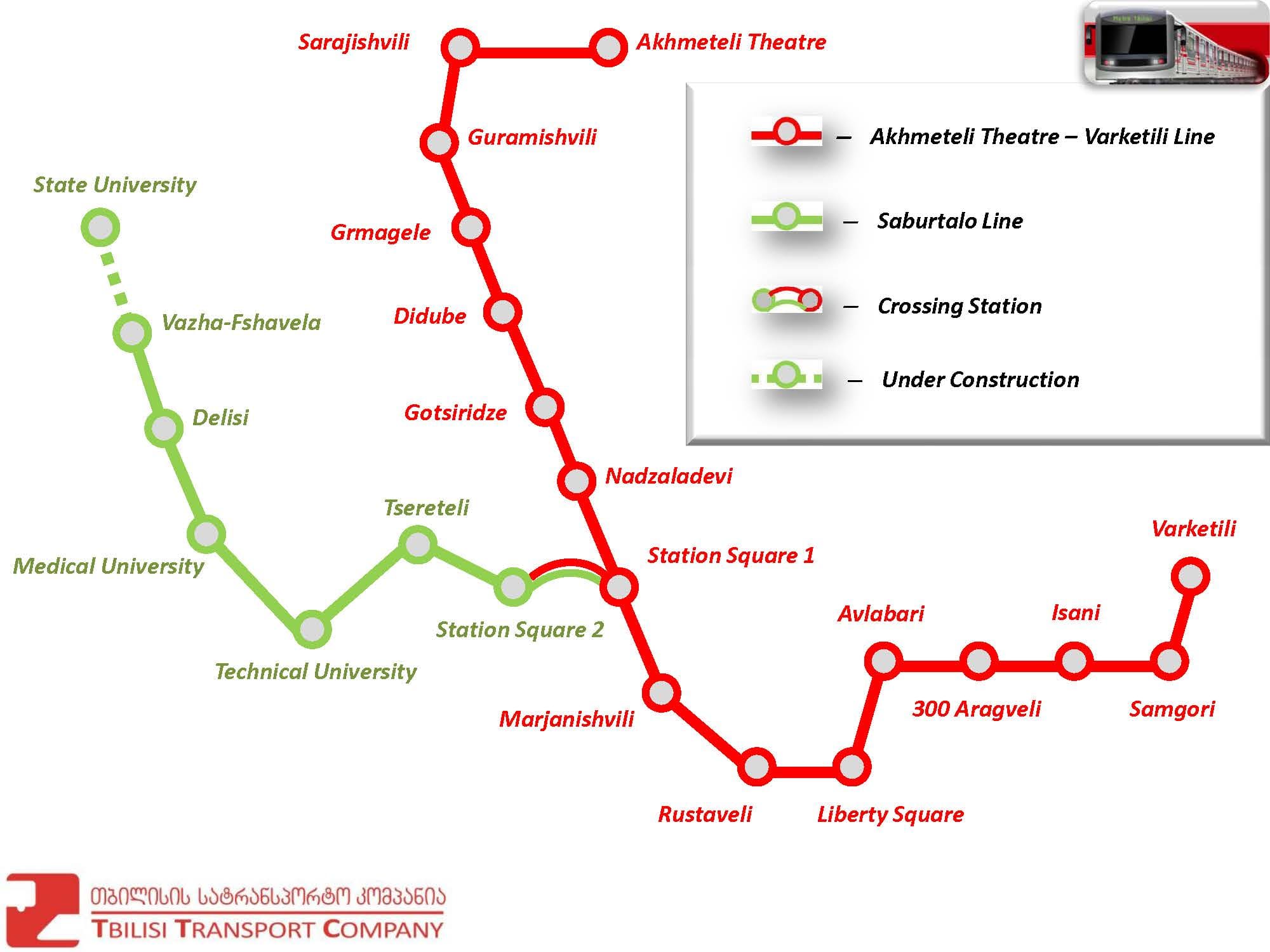
Some of the most useful stations include:
- Liberty Square: Right in the city center, great for accessing Old Tbilisi
- Station Square: Connects to the central railway station and regional marshrutkas
- Didube: Main hub for marshrutkas to Kazbegi, Gori, and other destinations
Paying for the Metro
The easiest way to pay for the metro is by using any contactless bank card (Visa or Mastercard) or a mobile payment option like Apple Pay or Google Pay. Personally, I just tap my phone and go.
If you don’t have a contactless card or phone payment set up, you’ll need to buy a MetroMoney card. It’s a prepaid card you can get at any metro station for a small fee. Just top it up with credit and use it to tap in.
It’s also good to know that transfers between metro, bus, and cable car are free within 90 minutes of the first tap. So, getting around in Tbilisi is just very affordable.
More About Metro in Tbilisi
Most stations are clean and functional, but the system still feels like a remnant of the Soviet era.
One of the first things that stood out was how deep the metro runs. At stations like Rustaveli, the escalators are incredibly long, so long that the ride down can take nearly two minutes, almost as long as traveling between stops. Most people just stand still, and it’s not unusual to see someone sitting on the steps during the descent.
While there is English signage at most stations, especially near platforms and exits, the overall layout can still feel a bit confusing. Many stations have only one entrance, and there’s no fast in-and-out access like you’d find in more modern systems.
If you’re new to the city, it might take a few rides before you feel fully comfortable navigating it.
Cons of the Tbilisi Metro:
- No elevators in most stations. Long escalators are available, but there’s little accessibility for wheelchair users or people with limited mobility.
- Some trains don’t have air-conditioning. Older models can be hot and stuffy in summer, while newer ones are being introduced with proper ventilation and cooling.
- Coverage is limited. Large areas of the city, like Vake and parts of Saburtalo, aren’t served by metro lines.
- No service after midnight. If you’re out late, you’ll need to switch to a taxi or ride-hailing app.
Despite these drawbacks, the metro is still the quickest and most cost-effective way to travel through Tbilisi, especially if your route falls along one of the two lines. It’s reliable, efficient, affordable, and simple once you get used to the system.
Tbilisi Buses
Operating hours: Generally from 7:00 AM to around 11:00 PM
Cost: 1 GEL per ride
The city buses in Tbilisi are modern, air-conditioned, and easy to use. Most are blue or green, with digital route displays in both Georgian and English. They run frequently throughout the city, covering main roads like Rustaveli and Chavchavadze as well as residential neighborhoods like Gldani, Saburtalo, and Varketili.
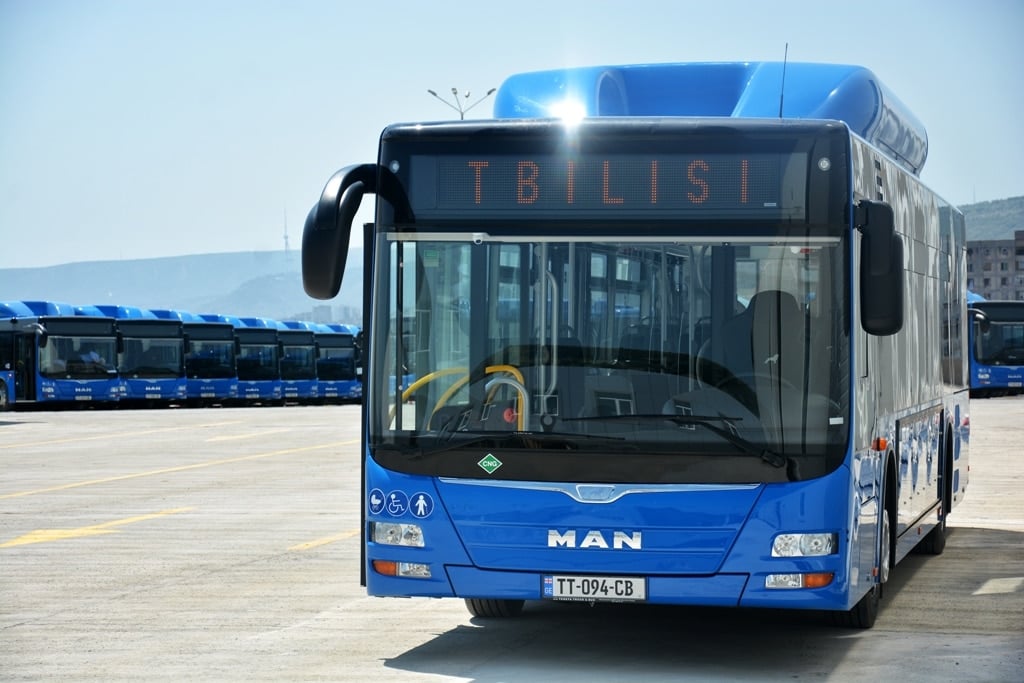
While the bus isn’t as popular as the metro among expats, locals still use it regularly. It actually covers more areas and reaches neighborhoods that don’t have metro access, like Vera, for example.
Available Routes
The buses follow fixed routes and stop only at designated bus stops. Many stops have electronic signs showing real-time arrival info. Google Maps is quite accurate for planning trips.
The Tbilisi Transport Company website also offers a route planner and live tracking.
Paying for the Bus
Paying for the bus here is similar to paying for a metro. It’s cashless system where you can pay using a MetroMoney card, any contactless bank card (Visa or Mastercard), or mobile payment methods like Apple Pay or Google Pay.
Just like the metro, each ride costs 1 GEL, and transfers between metro, bus, and cable car are free within 90 minutes if you use the same card. I often switch from metro to bus and finish with a short walk, all for one fare.
More About Buses in Tbilisi
The bus system has improved significantly in recent years. Vehicles are low-floor, making it easier to board, and most have working A/C.
The newer green buses are part of the city’s eco-transport initiative supported by the EBRD. They’re just as modern as the blue ones and follow the same fare system.
While bus signage is often in English, some interior announcements are only in Georgian, so following along on your phone helps if you’re not familiar with the area.
Buses in Batumi and Kutaisi
Both cities have smaller but functional bus systems:
- In Batumi, you’ll use the Batumi Card or contactless payment on yellow city buses. Routes are posted at stops, and prices are similar to Tbilisi.
- In Kutaisi, buses (and marshrutkas) are more limited. You pay in cash to the driver, and signs may only be in Georgian. You may need to ask a local or hotel staff for exact routes if you’re unsure.
While apps and signage have improved in recent years, don’t expect perfect English-language support everywhere. Still, once you learn how to pay and which numbers go where, using public transport in these cities becomes second nature.
Marshrutkas (Minibuses)
Operating hours: Vary by route, generally from early morning to early evening
Cost: Usually 1–2 GEL within the city, more for intercity routes
If you’re looking to experience public transport the way most locals do, marshrutkas are part of everyday life in Georgia. They are basically a small van, usually seating 12 to 15 people in tight rows.
These marshrutkas run on fixed routes but make flexible stops, covering both city streets and remote areas no bus or metro ever touches.
While it can be hard to use, some people still hop on since they can be faster than taking a bus. They’re not always the most comfortable, but they’re direct and quick.
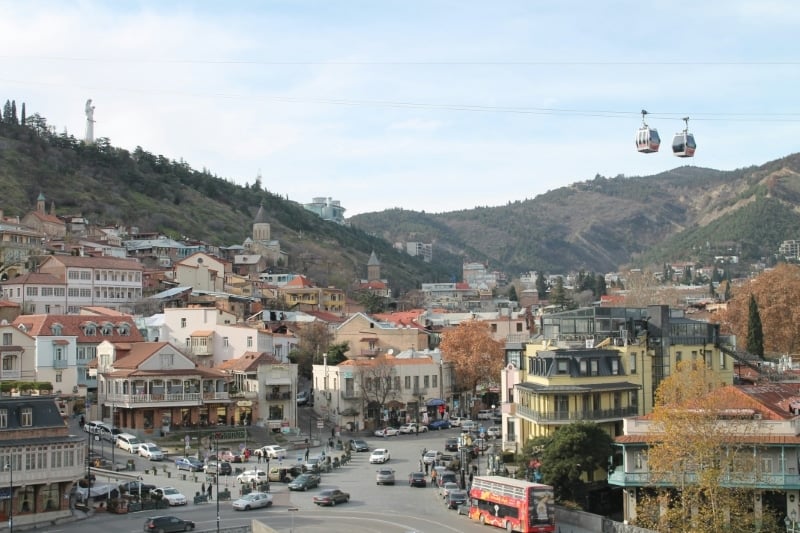
How to Find Marshrutka Routes
This part can be tricky at first, but it gets easier with experience.
For local (city) marshrutkas in Tbilisi:
- Use Google Maps or the Tbilisi Transport Company app. While not all marshrutkas are listed, many of the main ones are.
- Some stops have printed or posted route maps, usually on the side of the shelter.
- You can also find route numbers painted directly on the vehicle, often alongside a list of key stops in Georgian. If unsure, ask a local or check with shopkeepers nearby. They often know the routes by heart.
How to Use the Marshrutka
If you want to try taking a marshrutka, the process is simple once you know what to expect. To flag one down, stand somewhere visible and raise your hand as the van approaches. It’ll stop if there’s space.
If you’re already at a bus stop, just make eye contact with the driver or step slightly forward, they’ll understand you’re waiting to board.
When you’re ready to get off, say “აქ გააჩერეთ” (aq gaacheret), which means “stop here.” You can say it softly or just gesture toward the door. Drivers are used to it.
You’ll need to pay in cash directly to the driver. If you’re seated in the back row, it’s common to pass your fare forward through other passengers. They’ll hand it to the driver for you and return your change the same way.
That said, there are a few things to keep in mind:
- If you don’t speak Georgian, using marshrutkas can be a challenge. Most drivers don’t speak English, and signage is often only in Georgian.
- Finding the correct route isn’t always easy. The best source of info is often a local Georgian friend, but even they might not know every route. Metro and buses are simply more common these days.
- If you’re taller than 180cm, the seating can be uncomfortable.
- Front seats are usually reserved for women or elderly passengers, especially on city routes.
Despite the quirks, marshrutkas are a great way to travel like a local. They are fast and will take you to places that other forms of public transport simply don’t reach.
Taxis and Ride-Hailing Apps in Georgia
Operating hours: 24/7 (depending on the city and app availability)
Cost: Varies by distance and app; typically 5–8 GEL for a 15-minute ride in Tbilisi
Taxis are widely available in Georgia, especially in cities like Tbilisi, Batumi, and Kutaisi. While you’ll still see traditional street taxis, most people, especially expats, prefer ride-hailing apps. They’re safer, cheaper, and much easier to use than trying to negotiate with drivers, many of whom don’t speak English.
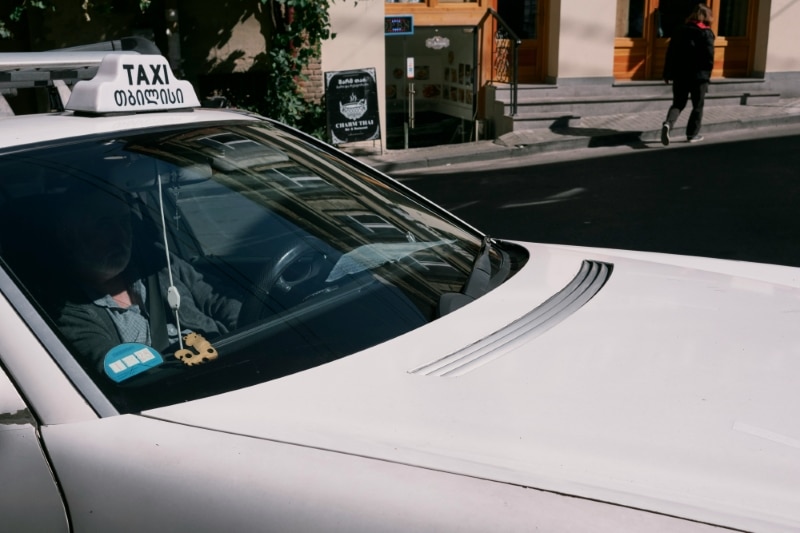
Fortunately, you can use Bolt to get around Tbilisi. It’s basically a ride-hailing app that works in many cities in the world. You can also link to your Wise card directly in the app for easy payment. In addition to Bolt, you’ll also find Yandex Go and Maxim, which offer similar services with slightly different pricing and availability.
These apps work well in most major cities and are especially helpful late at night, after the metro and buses stop running.
Traveling Between Cities
Once you’re outside the major cities, getting around Georgia requires a bit of planning. Fortunately, there are several ways to travel between regions, each with its own pros, limitations, and price points.
Here’s a breakdown of the main transportation options you can use to get from one city to another.
Intercity Marshrutkas and Buses
Cost: 10–35 GEL depending on the distance
Booking: No advance booking. Just show up and pay the driver
Marshrutkas remain the most common way to travel between cities and towns in Georgia. They run frequently, depart when full, and cover nearly every destination, even places off the main tourist trail.
Main Routes from Tbilisi
- Kazbegi (Stepantsminda): Leaves from Didube Station, about 3.5 hours
- Kutaisi: Leaves from Station Square or Didube, 3–4 hours
- Batumi: Leaves from Ortachala or Station Square, 5–6 hours
- Telavi (Kakheti wine region): Leaves from Ortachala, 2–2.5 hours
Where to Find Bus Terminals
There are three main intercity terminals in Tbilisi. These stations don’t look like modern, organized bus terminals you might expect in Western Europe. They’re more informal, open-air lots where drivers call out destinations and wait for their vans to fill up before departing.
Here’s what you need to know about the three main hubs:
Didube Station (Google Map link)
- Best for: Northern and western destinations
- Typical routes: Kazbegi (Stepantsminda), Gori, Kutaisi, Zugdidi
- How to get there: Take the metro to Didube Station, then follow the crowds up the escalator and toward the outdoor lot
Ortachala Bus Station (Google Map link)
- Best for: Eastern and southern routes, including cross-border travel
- Typical routes: Telavi (Kakheti wine region), Rustavi, Tsnori, and some international routes to Armenia, Azerbaijan, or Turkey
- How to get there: Located in southeastern Tbilisi, accessible by taxi or bus
- This station is quieter but more spread out. Look for destination signs on the windshields or small ticket offices for longer-distance travel.
Station Square (Railway Station Area) (Google Map link)
- Best for: Kutaisi, Batumi, and shorter routes to nearby towns
- Typical routes: Kutaisi, Batumi, Borjomi, Mtskheta, or Gori (alternative to Didube)
- How to get there: Right next to Station Square Metro, near the main train station
**Some marshrutkas leave from the back lot, while others depart from near the sidewalk. It’s not clearly marked, so give yourself time to ask around.
Georgian Railway
Cost: 15–60 GEL depending on the route and class
Booking: Online at Tkt.ge or Railway.ge, or in-person at the station
If you’re traveling long distances in Georgia and want a more comfortable, scenic alternative to marshrutkas, the train is a solid option.
Traveling with a train is better than sitting in a marshrutka for six hours. The seats are wide and assigned, the cabin stays quiet, and the whole ride can make you feel more relaxed. When you are bored, you can also walk around to relax yourself.
It’s not a high-speed system, but the trains are clean, reliable, and especially great if you’re carrying luggage or just want to sit back and enjoy the view of the countryside.

Key Routes
Here are some of the main intercity rail routes as of 2025:
- Tbilisi – Batumi (5 hours): The most popular route, served by modern Stadler-built express trains with comfortable seating and panoramic windows.
- Tbilisi – Zugdidi (8 hours): Slower but scenic. Most travelers use this to access Svaneti. You’ll transfer to a marshrutka in Zugdidi for the final leg to Mestia.
- Tbilisi – Ozurgeti or Poti: Less frequent than other routes, but great if you’re heading to the western coast or looking for a quieter option.
- Tbilisi – Baku (Azerbaijan): The international night train to Baku resumed in 2024. The border crossing is handled during the night with no need to get off the train.
How to Book a Train Ticket
You have a few booking options depending on your preference:
- Tkt.ge: The most user-friendly site, especially for English-speaking travelers. You can select your seats and pay by card.
- Railway.ge: The official Georgian Railway site. Occasionally shows more real-time availability, though the interface is clunky and doesn’t always load in English.
- In-person at Station Square: Go to the main railway station in Tbilisi with your passport or ID. I once bought a last-minute ticket this way. The staff were helpful despite the language barrier.
Tip: For international routes like Tbilisi–Baku, advance booking is essential and you’ll need your passport details when purchasing.
Classes of Service
There are three main classes of Georgia’s trains:
- 1st Class (Business): Spacious seats, air-conditioning, tray tables, and power outlets.
- 2nd Class: Still comfortable and clean, just less legroom and no power outlets. It’s totally fine for a 4–5 hour journey. This is my preferred choice.
- Sleeper Cars: Available for overnight routes like Tbilisi–Zugdidi or international trains. Compartments may have 2 or 4 beds.
What to Expect Onboard
Before you board, here’s what you should know to prepare for the journey:
- Food: No food service onboard. Some express trains may have vending machines offering snacks, water, and soft drinks. It’s best to grab food and drinks before boarding.
- Luggage: You can find large luggage racks at the ends of each carriage, while overhead shelves handle smaller backpacks.
- Toilets: Toilets are okay. The cleanliness is acceptable, though not fancy. It’s recommended to carry tissues and hand sanitizer just in case.
- Wi-Fi: While most Tbilisi–Batumi express trains have Wi-Fi available, don’t expect it to always work. It can be better to use mobile data.
In my opinion, while trains in Georgia aren’t perfect. It works. I think it’s just the most comfortable way to travel between cities like Tbilisi and Batumi.
Domestic Flights
Cost: 90 to 120 GEL one-way.
Booking: Vanilla Sky Official website.
I had a hard time finding information about domestic flights in Georgia at first since details are quite limited. When I dug deeper, I found that domestic flights aren’t very popular. Georgia is a small country, so most people travel between cities by train or bus. Flights are usually only used for reaching a few remote mountain areas with limited access by road.
Vanilla Sky Airlines is the only domestic airline operating in Georgia. Flights depart from Natakhtari Airfield, located about 30 minutes north of Tbilisi, and connect to a few destinations, including Mestia (in the Svaneti region) and Ambrolauri (in Racha).
Here are a few things to know before booking:
- Flights are operated on small planes with limited seating and minimal luggage allowance.
- If you book in advance, you can arrange a free shuttle from central Tbilisi to the airport.
- While Vanilla Sky has an official website, online booking doesn’t always work. Sometimes it shows no availability, even when there are seats. If that happens, it’s best to message their official Facebook page.
- Flights don’t run every day, so you’ll need to plan around their schedule.
- Weather can affect routes, especially to mountainous areas like Mestia, so delays and cancellations do happen.
Because of all this, most people take domestic flights only for specific reasons, usually when time is tight or the roads are too rough. Personally, I stick to trains unless I’m in a rush or traveling with someone who gets carsick in the mountains.
Car Rental
Cost: Around 90–120 GEL per day for a basic rental
Booking: Through platforms like DiscoverCars.
In my opinion, you don’t need to rent a car unless you want to explore remote areas of the country like Kakheti, Svaneti, or Tusheti. Those are areas that marshrutkas don’t reach.
Also, I don’t recommend driving a car in Tbilisi. Parking can be an issue there. It’s hard to find a parking spot, and paying for parking can be complicated for travelers.
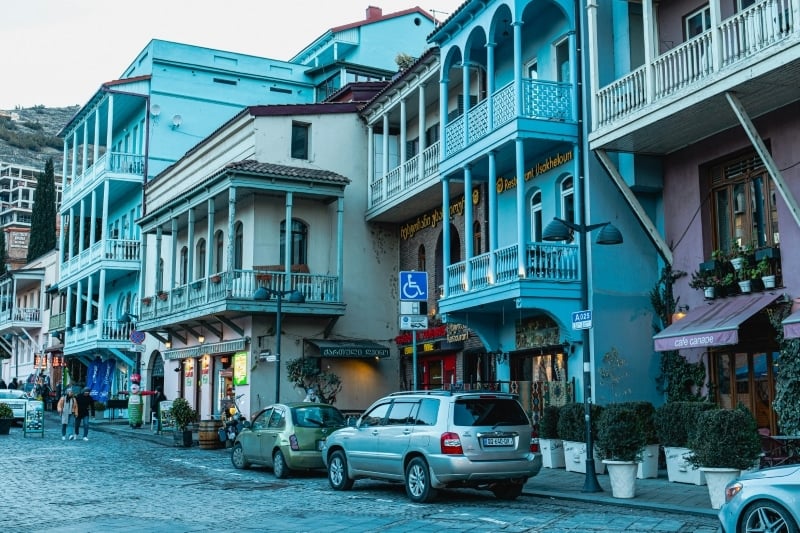
Recommended Car Rental Companies
Car rental options in Georgia are similar to most cities in the world.
- Local companies: There are local companies that tend to be cheaper and more flexible, but the car’s condition totally depends on your luck.
- International companies: If you want a better standard at a slightly higher price, Sixt, Hertz, and Avis are available here. These rental car companies can be found at major airports like Tbilisi and Batumi.
You can use a car rental website like DiscoverCars to book in advance.
Requirements
There are a few things you should know if you want to drive in Georgia:
- Driver’s license: You need a valid driver’s license from your home country or an International Driving Permit (IDP) if your license is not in Georgian or Latin script
- Minimum age: 21 to 23 years old, depending on the rental company
Is It Easy to Drive in Georgia?
Driving in Georgia is manageable for most people, but it takes a bit of adjustment, especially if you’re used to strict road rules and well-marked signs.
While the highways are generally in good shape, local driving habits can be unpredictable. Drivers often overtake suddenly, ignore lane markings, and treat road rules more like suggestions than laws.
That said, if you stay calm, drive defensively, and go with the flow, it’s not too difficult to adapt.
Caution: If you plan to drive on mountain roads (like those to Tusheti or some parts of Svaneti), you need to rent a 4WD and have driving experience. Roads are often unpaved, narrow, and can be dangerous.
Transportation Options Comparison
Georgia has a wide range of transportation options, from modern metros and city buses to Soviet-era marshrutkas and domestic flights. Each has its pros and cons depending on where you’re going, your budget, and your comfort level.
Here’s a quick comparison table to help you decide which one fits your trip best:
| Mode of Transport | Best For | Coverage | Cost | Pros | Cons |
| Metro (Tbilisi only) | Fast city travel in Tbilisi | Only Tbilisi | 1 GEL/ride | Fast, cheap, reliable | Limited coverage, no A/C in older trains |
| City Buses | Wider city coverage including non-metro areas | Tbilisi, Batumi, Kutaisi | 1 GEL/ride | Air-conditioned, real-time info | No late-night service, announcements in Georgian |
| Marshrutkas (Minibuses) | Flexible stops & remote areas | All over Georgia | 1-2 GEL in city; more for intercity | Flexible, fast, goes where others don’t | Uncomfortable, hard to navigate without Georgian |
| Taxis / Ride-Hailing Apps | Convenience and late-night travel | Major cities | 5-15 GEL within cities | Cashless, quick, safe with apps | Traditional taxis may overcharge |
| Trains | Comfortable long-distance travel | Across major cities | 15-60 GEL | Scenic, clean, relaxed | Limited routes, slower than flying |
| Domestic Flights | Reaching remote mountain areas quickly | Limited routes (e.g., Mestia, Ambrolauri) | 90-120 GEL (one-way) | Fastest to remote locations | Unreliable booking, weather delays |
| Rental Cars | Exploring rural/mountainous regions | Nationwide | Varies (30-60 USD/day) | Total flexibility, reach anywhere | Driving habits, road hazards, parking in cities |
Useful Apps and Websites to Navigate Georgia
Georgia’s transportation system is easiest to navigate when you’ve got the right tools on your side. Below are the must-have apps and payment options to help you explore with ease:
Must-Have Apps
- Tbilisi Transport App: Official tool for metro, buses, and cable cars—live tracking, routes, and QR payments.
- Google Maps: Ideal for navigating cities, finding transit routes, and walking directions.
- Bolt: The most reliable ride-hailing service in Georgia, widely available and user-friendly.
- Yandex: A popular alternative with competitive pricing.
- Maxim: Budget ride-hailing option; best for short trips.
- Tkt.ge: The easiest English-language platform for booking Georgian railway tickets.
- DiscoverCars: Convenient platform to browse and book car rentals from both local providers and international brands.
Payment Systems
- MetroMoney Card: Prepaid card used across metro, bus, and cable car systems. Available at metro stations for a small deposit.
- Contactless Visa/Mastercard: Accepted on most metro and bus services. You can simply tap your card or mobile wallet (Apple Pay/Google Pay).
Additional Safety Tips and Local Etiquette
Georgia is a pretty safe country, and getting around is straightforward once you get the hang of it. Still, a few local habits and safety tips can go a long way, especially if you’re using public transport or renting a car.
When I first moved here, it took me a few weeks to adjust. People drive fast, and rules feel more like suggestions than strict laws. Here’s what you should know:
- If you’re crossing the street, don’t assume cars will stop, even at zebra crossings. Make eye contact with the driver first.
- In marshrutkas or crowded buses, keep your backpack in front and hold onto your phone and wallet.
- Offer your seat to elderly passengers or mothers with children. In marshrutkas especially, front seats are usually left for older women.
- Say “gmadlobt” (thank you) when paying the driver or getting off a bus. It’s a small word, but people really appreciate it.
- On escalators (like at Tbilisi metro stations), stand on the right if you’re not walking.
- Don’t talk loudly on public transport. Georgians tend to keep to themselves during rides, and it’s seen as polite to stay quiet.
Frequently Asked Questions
If you’re planning to get around Georgia, especially as a first-time visitor, you might have a few questions about transport, safety, and payment methods. Here are some of the most commonly asked questions based on real traveler experiences.
Is Uber available in Georgia?
No, Uber doesn’t operate in Georgia. Most people use ride-hailing apps like Bolt, Yandex Go, or Maxim, which are available in major cities including Tbilisi, Batumi, and Kutaisi.
Is public transportation accessible for seniors or people with disabilities?
Not entirely. Most metro stations lack elevators, and escalators can be steep and long. Marshrutkas are also not designed for people with mobility issues. The city bus system is more accessible, especially the newer low-floor green buses in Tbilisi.
Can I pay for buses in Tbilisi with my foreign credit card?
Yes, you can tap any contactless Visa or Mastercard to pay for metro, bus, and cable car rides. Apple Pay and Google Pay also work without needing a local SIM or bank account.
Do I need an International Driving Permit (IDP) to rent a car in Georgia?
If your license isn’t in Georgian or Latin script (like English or French), you’ll need an IDP. Most rental companies accept EU, US, and UK licenses without issue, but it’s always best to double-check.
What is the absolute cheapest way to travel across Georgia?
Marshrutkas are the cheapest. They run on fixed routes and cost anywhere from 5 to 20 GEL depending on distance. Trains are also very affordable and more comfortable for longer journeys.
How do I get from Tbilisi Airport to the city center?
You can take:
- Bus #337, which runs 24/7 and costs just 1 GEL
- Bolt or Yandex Go, which cost around 25–35 GEL
- A private transfer, which is more convenient but more expensive
How much does a taxi from Tbilisi Airport to the city center cost?
Using a ride-hailing app, expect to pay around 25–35 GEL depending on traffic and time of day. Avoid taking a taxi directly from the curb unless you confirm the price first.
Is it safe to drive in Georgia?
Generally, yes, but it requires some adjustment. Road conditions can vary, and local drivers tend to be aggressive, especially when overtaking. If you plan to drive in the mountains, rent a 4WD and avoid night driving.








